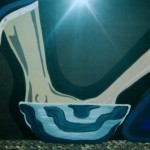It’s Christmas again! And like the tensile and lights, it’s time to pull out those well worn advent passages we’re all familiar with.
- Prophecies about Jesus coming (Isaiah 9 and Micah 5)
- Narratives about Jesus birth (Matthew 1-2, Luke 1-2 and Revelation 12).
- Reflections on the incarnation, the fact that God became man (John 1 and Philippians 2)
How about a new passage to read and preach this year? John 13 is not typically associated with Christmas and yet it has the birth of Jesus written all over it. Here’s how.

Water in John is an important symbol of purification and the Spirit.
John 13 isn’t the only time water plays a significant role in this gospel. Beginning in chapter one, John the Baptist states three times that he baptizes in “water” (1:26, 31, 33) only then to proclaim that Jesus will “baptize in the Holy Spirit” (1:35). Jesus changes water into wine (2:9), proclaims a new birth of “water and Spirit” (3:5) and offers the Samaritan woman “living water” (4:10). He heals a paralytic longing to be cured in a troubled pool (5:7), invites the thirsty to come to him and drink (7:37-38) and opens the eyes of the blind in the pool of Siloam (9:6-7). Ultimately, Jesus in death releases a flow of water from His pierced side (19:34).
What do all these references to water mean?
Sometimes water is simply a clear physical liquid used for rituals of purification. However when associated with Jesus, water in John represents the Spirit (7;37-38). By comparing and contrasting these two meanings, John makes clear the supremacy of Christ’s Spirit over earthly cleaning. (See my post, Jesus is Greater: What does Water Mean? for more details.)
Jesus is a container of water which represents the Spirit.
It’s not enough though to say water refers to purification and the Spirit. In John 7:37-38, Jesus prophecies “living water” will flow from within Him and in 19:34 we find it doing just that. Jesus is literally a container of water!
This water also comes from Jesus in John 11, at the tomb of Lazarus. John says Jesus was “troubled” and “wept” or more literally “shed tears.” The word “trouble” points back to the first time this word is used in John. In chapter five it refers to the waters of Bethesda (5:7). The water heals when the water is “troubled” and so too does Jesus here, raising Lazarus from the dead.
The water also comes from Jesus in John 9. Remember it’s Jesus’ spit mixed with clay which opens the eyes of the man born blind (9:3).
The Water within Jesus’ is His Divine nature.
In 1 John 5:6, John says Jesus Christ “came by water and blood; not with water only with water and blood.” The blood here clearly stands for Jesus’ fleshly nature which some erroneously denied (see 1 John 4:2 and 2 John 7).
If the water associated with Jesus in John represents the Spirit (7:37-39) than the only conclusion we can draw here is that water stands for Christ’s Divine nature as opposed to this fleshly nature. John 1:14 says, “the Word became flesh and dwelt among us.” The water signifies the intangible Word. (See my post, Finally Someone Gets the “Water and Blood” Right! for more details).
In John 13 the washing with water is explicitly connected with Jesus. When Peter refuses the humble service of His Lord, Jesus tells him, “Unless I wash you, you have no part with me.” By refusing the washing, Peter has inadvertently rejected Jesus himself.
Jesus pours water into a bowl to symbolicly reenact His birth.
John 13 is about the self humbling of Jesus. Knowing his intimate union with God (13:3), Jesus
got up from supper, and laid aside His garments; and taking a towel, He girded Himself. Then He poured water into the basin, and began to wash the disciples’ feet and to wipe them with the towel with which He was girded.
This humbling is significantly reminiscent of an early Christian hymn found in Philippians 2:5-8,
Your attitude should be the same as that of Christ Jesus: Who, being in very nature god, did not consider equality with god something to be grasped, but made himself nothing, taking the very nature of a servant, being made in human likeness.
In both accounts, Jesus equal with God progresses to the role of a servant. In John, Jesus “makes himself nothing” by “laying aside His garments” to dress the part of a slave.
The water poured into basin likewise expresses the self humbling of Jesus. The Word became flesh (1:14). In Jesus, the water becomes contained. It’s no coincidence that John, the only gospel to recount the foot washing, is also the only gospel to explicitly proclaim the incarnation (John 1:14).
John replaces the communion recorded in Matthew, Mark and Luke with foot-washing because it symbolizes not just Christ’s sacrifice of his flesh in death but the humbling in his birth and life as well.
This Christmas Jesus has left an example we should follow. Will you humble yourself and do the same?
What do you think?
















